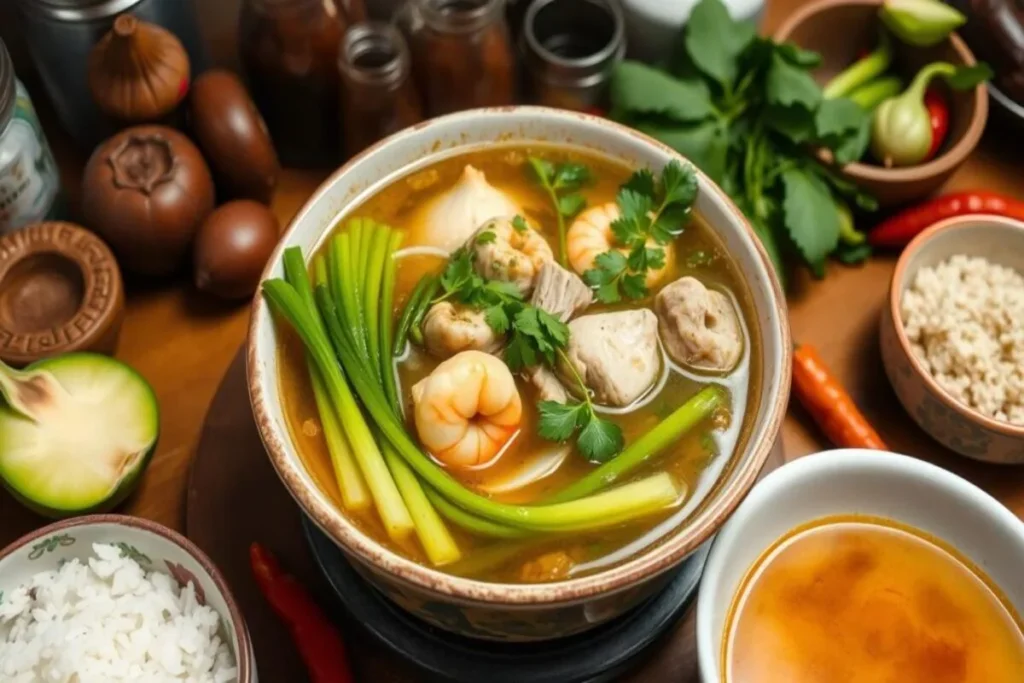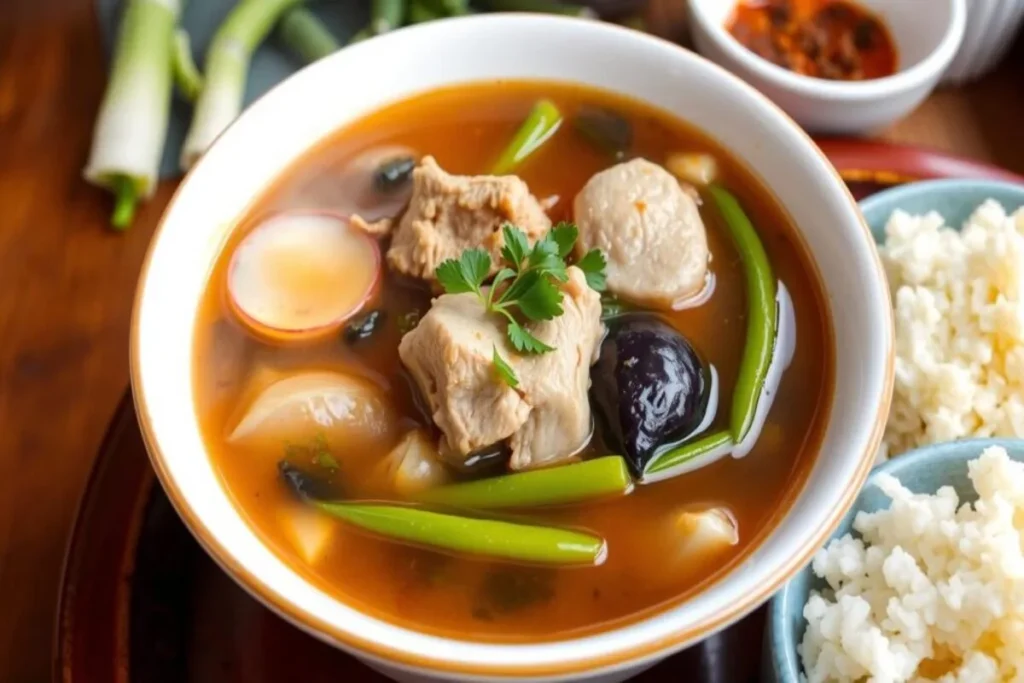Imagine a warm, savory bowl of Filipino sour soup that takes you to the Philippines’ tropical islands. This is what a traditional sinigang recipe offers – a mix of sour and savory flavors that makes you want more. It’s a tamarind soup recipe that blends tangy tamarind broth with veggies and proteins, making a unique and tasty Filipino dish.
A great sinigang recipe is more than a list of ingredients – it’s an experience that brings people together. This Filipino sour soup is a beloved dish in many Filipino homes. In this article, we’ll explore sinigang’s origins, common ingredients, and guide you on how to make the perfect tamarind soup recipe.
What is Sinigang?
Sinigang is a traditional Filipino dish loved for centuries. It’s a sour soup with tamarind, tomatoes, onions, and proteins like pork, beef, and fish. The sinigang na baboy, or pork sinigang, is a favorite for its special taste and cooking way.
The history of sinigang is tied to Filipino culture, starting before the Spanish came. Over the years, different parts of the Philippines made their own sinigang. Now, it’s a favorite comfort food across the country.
The Origins of Sinigang
The exact start of sinigang is unclear, but it’s thought to come from the south of the Philippines. It was likely shaped by the indigenous people, who used tamarind and other sour things to flavor their meals.
Common Ingredients in Sinigang
Common sinigang ingredients are tamarind, tomatoes, onions, garlic, and proteins like pork, beef, and fish. The protein choice depends on the region and personal taste. For example, sinigang na baboy uses pork. It’s often eaten with steamed rice, which balances the sour taste of the soup.
Sinigang is not just tasty; it’s also good for you. It’s packed with vitamins and minerals, making it a healthy choice for a traditional Filipino meal. Whether you prefer sinigang na baboy or another version, sinigang will surely satisfy your taste buds and leave you wanting more.
Essential Ingredients for Sinigang
To make a delicious sinigang, you need the right ingredients. The key to a great sinigang recipe is its essential parts. These include proteins, vegetables, and a tamarind base.
The tamarind base is the heart of the soup, giving it a unique sour flavor. You can use fresh, dried, or powdered tamarind. For an easy recipe, powdered tamarind works well. But for a more authentic taste, fresh or dried tamarind is better.
Tamarind Base: The Heart of the Soup
To make the tamarind base, mix it with water to create a broth. The tamarind to water ratio depends on how sour you like it. To balance the flavor, add tomatoes, onions, and fish sauce.
Vegetables to Include
Common vegetables in sinigang are bok choy, spinach, and okra. These add texture and flavor. You can also try eggplant, bell peppers, and string beans.
Proteins: Options and Flavors
Pork, beef, and fish are popular protein choices for sinigang. Use pork ribs, beef brisket, or fish like milkfish or tilapia. The protein you choose changes the flavor, so try different ones to find your favorite.
By mixing these essential ingredients, you can make a delicious sinigang. Remember to balance the flavors and adjust the sourness to your liking. With practice, you’ll get better at making a great sinigang recipe.
Step-by-Step Sinigang Recipe
To make a tasty sinigang recipe, start by making the tamarind broth. This is the heart of the dish. It takes some planning, but it’s all worth it. You can try pork sinigang or use shrimp or chicken for a change.
Here’s a quick guide on how to cook sinigang:
- Start by boiling tamarind fruits in water and then straining the mix.
- Add veggies like tomatoes, onions, and bok choy to the pot, along with your protein.
- Season with fish sauce, salt, and pepper to get the right mix of sour and savory.
When making pork sinigang, pick the right cut of meat. Pork belly or shoulder works well because they get tender and flavorful. You can also add garlic, ginger, and long green peppers for extra taste.
By following these steps and using fresh ingredients, you’ll make a delicious, authentic sinigang. It’s sure to wow your family and friends.
Traditional vs. Modern Sinigang
Sinigang soup, a traditional Filipino sour soup, has evolved over time. Different regions in the Philippines have created their own versions. They use local ingredients and cooking techniques, leading to a variety of flavors.
Modern sinigang recipes often include tomatoes and patis (fish sauce) for a richer taste. They also use blanching and sautéing to keep vegetables’ texture and color. Traditional recipes, on the other hand, stick to simpler ingredients and methods. This highlights the tamarind broth and fresh vegetables’ natural flavors.
Choosing between traditional and modern sinigang recipes depends on personal taste. Those who prefer a classic flavor might choose the traditional recipe. But, those looking for something new might enjoy the modern twist.
Some popular sinigang soup variations include:
- Sinigang na baboy, with pork as the main ingredient
- Sinigang na baka, featuring beef
- Sinigang na isda, with fish as the star
These variations offer unique takes on the traditional sinigang recipe. They can be made using either traditional or modern cooking methods.
Popular Variations of Sinigang
Sinigang is a versatile dish that can be made with various proteins. Each protein gives it a unique flavor. Sinigang na baboy, made with pork, is a favorite for its rich flavor.
Sinigang na baka uses beef and is great for those who like a heartier taste. The beef adds a deep flavor, perfect for special occasions.
Sinigang na isda, made with fish, offers a lighter and fresher taste. It’s ideal for those looking to try a different twist on the classic sinigang recipe. The fish adds a delicate flavor.
These variations of sinigang offer a range of flavors and textures. Whether you prefer the rich flavor of sinigang na baboy, the hearty flavor of sinigang na baka, or the light flavor of sinigang na isda, there’s a version for everyone.
Some key ingredients to keep in mind when making these variations include:
- Tamarind broth
- Vegetables such as tomatoes and spinach
- Proteins such as pork, beef, or fish
By experimenting with different ingredients and flavor combinations, you can create your own unique version of sinigang. It’s sure to please even the pickiest of eaters.
Cooking Tips for Perfect Sinigang
To make perfect sinigang, follow some key cooking tips. Choosing fresh ingredients is very important. This means picking the best tamarind, vegetables, and proteins for your sinigang recipe. Fresh ingredients ensure your sinigang tastes rich and authentic.
Choosing Fresh Ingredients
The quality of your ingredients greatly affects sinigang. For a tasty and authentic sinigang, use fresh, high-quality ingredients. This makes your dish not only flavorful but also healthy and nutritious.

Balancing Sourness and Seasoning
Getting the right balance of sour and savory flavors is key in sinigang. Adjust the tamarind and other seasonings to get it just right. These tips will help you make a delicious, authentic sinigang that will impress everyone.
With these tips and a simple sinigang recipe, you can make a dish that’s both tasty and easy. Whether you’re new to cooking or experienced, these tips will help you make perfect sinigang every time. So, try it out and enjoy the delicious, authentic taste of sinigang.
Serving Suggestions
Serving sinigang soup, a traditional Filipino sour soup, offers endless possibilities. This tamarind soup recipe is a staple in Filipino cuisine. Its sour flavor pairs well with many dishes. A steaming bowl of sinigang soup goes great with steamed rice, balancing its sourness.
For extra flavor and texture, try pairing it with grilled meats like pork or chicken. Add fresh vegetables like tomatoes and green onions too. The smokiness of the meats and the freshness of the veggies contrast nicely with the sour soup.
What to Pair with Sinigang
- Steamed rice: a classic pairing that helps to balance out the sourness of the dish
- Grilled meats: such as pork or chicken, which add a smoky flavor to the sinigang soup
- Fresh vegetables: like tomatoes and green onions, which add a nice contrast in texture
Garnishes for Extra Flavor
To enhance your sinigang soup, use garnishes like patis (fish sauce) or fresh calamansi juice. These add extra flavor and a burst of citrus. With these tips, you can enjoy your sinigang soup in a new and delicious way.
Frequently Asked Questions
Many people wonder about cooking sinigang. One big question is if you can use something else instead of tamarind. Traditional sinigang uses tamarind, but some might not have it or want a different taste.
In a pork sinigang, you can try using lemons or limes as a tamarind substitute. But remember, the taste will be a bit different. For a true sinigang flavor, it’s best to use tamarind.
Can I Use Alternatives to Tamarind?
- Lemons or limes can be used as a substitute for tamarind in a sinigang recipe.
- Other sour ingredients like tomatoes or citrus fruits can also be used.
- Keep in mind that the flavor will be slightly different from traditional sinigang.
How to Store Leftover Sinigang?
To store leftover sinigang, cool it down first and then refrigerate it. You can also freeze it for later. When reheating, make sure it’s hot all the way through to avoid illness. These tips help you enjoy your sinigang, including pork sinigang, for longer.

Health Benefits of Sinigang
Sinigang soup is a traditional Filipino sour soup with many health benefits. It’s made with tamarind, which is full of vitamin C and antioxidants. This makes it great for boosting your immune system. The vegetables and proteins in sinigang soup add even more nutrition.
The ingredients in sinigang, like tamarind, tomatoes, and leafy greens, are packed with vitamins and minerals. Tomatoes are full of lycopene, an antioxidant that helps protect against heart disease and some cancers. The proteins in sinigang, such as pork, beef, or fish, help build and repair muscles.
Some of the key health benefits of sinigang soup include:
- High antioxidant content, which helps protect against cell damage and reduce inflammation
- Rich in vitamin C, which supports immune function and collagen production
- Good source of fiber, which can help promote digestive health and support healthy blood sugar levels
Sinigang soup is both nutritious and tasty, making it a great addition to a healthy diet. Its unique sour and savory flavors have made it a favorite in many homes. Adding sinigang to your meals can bring many health benefits and a delicious taste.
Conclusion and Final Thoughts
As we wrap up our exploration of Sinigang, the authentic Filipino tamarind soup, we hope you now appreciate it more. This dish has a rich history and offers a wide range of flavors. It’s a versatile and satisfying meal that should be in every home cook’s collection.
If you love Filipino food or are new to it, we invite you to explore Sinigang recipes. Try different ingredients and techniques to find your favorite way to make it. The key is to balance the sourness, savory flavors, and fresh produce. With practice, you’ll soon make Sinigang that rivals restaurants.
So, why wait? Start making this easy Sinigang recipe and enjoy the flavors that have delighted people for years. Bon appétit, and happy cooking!
FAQ
Can I Use Alternatives to Tamarind?
Yes, you can use lemon or lime juice if tamarind is not available. It won’t taste exactly the same, but it’s delicious. It makes a tasty sour soup.
How to Store Leftover Sinigang?
Store leftover Sinigang in a sealed container in the fridge for 3-4 days. Reheat it until it simmers. You can also freeze it for up to 2-3 months. But, it tastes best when fresh.
Can I Make Sinigang Ahead of Time?
Absolutely, you can make Sinigang ahead of time. The flavors get better after a day or two. Just reheat it and add fresh herbs or veggies before serving.
What Proteins Can I Use in Sinigang?
Sinigang can have many proteins like pork, beef, fish, shrimp, or chicken. The protein you choose changes the flavor of the dish.
How Can I Adjust the Sourness of Sinigang?
Adjusting the sourness in Sinigang is key. If it’s too sour, add more water or broth. If it’s not sour enough, add more tamarind, lemon, or lime. Find the sourness you like best.

